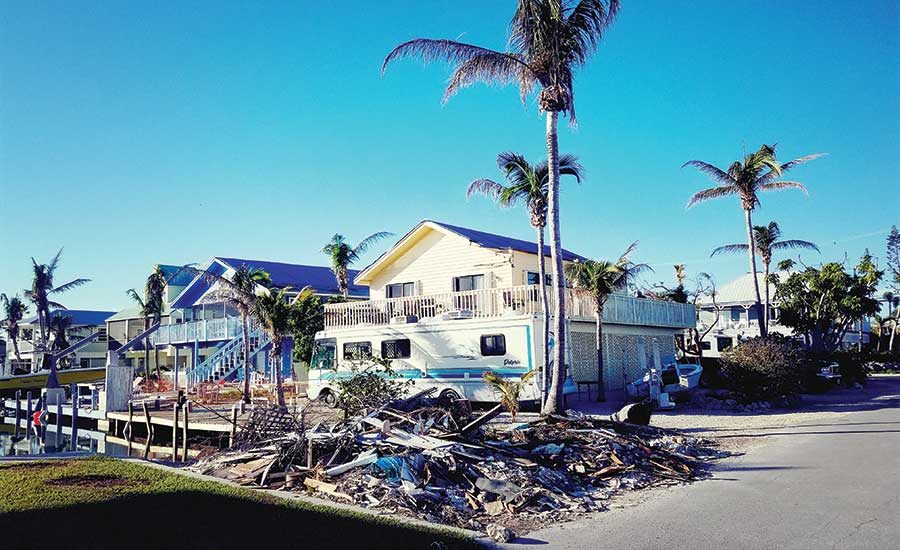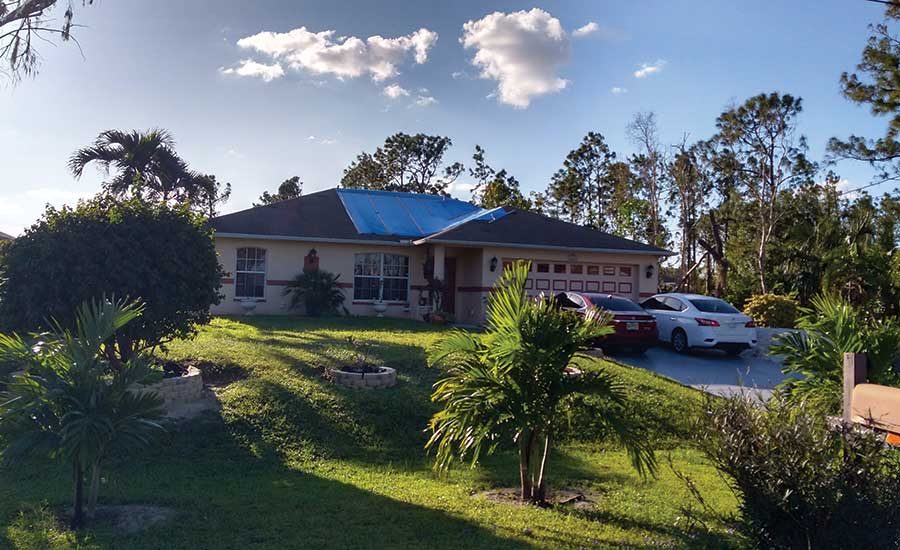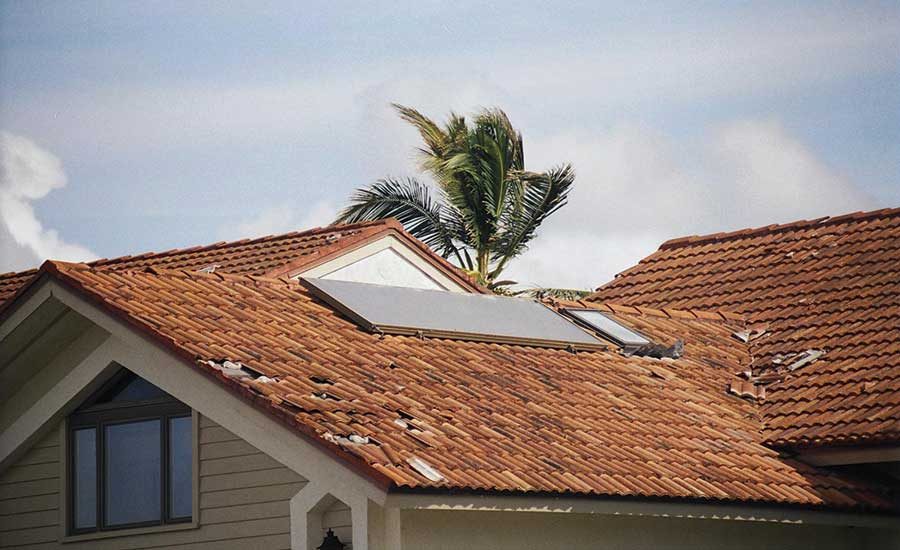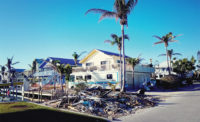Roof Repair: Hurricanes Irma, Harvey and Maria may Bring Tidal Waves of Changes to Building Codes
Severe storms Like Irma, Harvey and Maria may Bring Tidal Waves of Changes to Building Codes

Regardless of the roofing material, most homes in the paths of 2017’s major hurricanes sustained significant damage last fall. Blue tarps and large debris piles were a common site across the Gulf States for months as the recovery continued in places like the Florida Keys, pictured here. Photo by Mark Silvers.

Tarps on a Ft. Meyers home.




The 2017 hurricane season was considered to be unprecedented by many observers, but it may become the new normal. Storms like Irma, Harvey and Maria had such strength, speed and rain that governments may need to strengthen their own resilience against an increasing threat — which comes at a cost. And that added cost of tougher building codes and preventative measures has the potential to dominate the building industry — and roofers — for years to come.
Just like Hurricane Andrew in 1992 inspired a slew of stronger building codes throughout Florida, there may be another awakening after the devastation caused in Texas, Florida and Puerto Rico. William Lau, a scientist at NASA’s Goddard Space Flight Center, concluded in a 2012 paper that rainfall totals from tropical cyclones in the North Atlantic have risen at a rate of 24 percent per decade since 1988. Areas beyond the subtropics are also impacted as well. Severe regional snowstorms have also doubled in the last 50 years.
All of this means creating building materials that can withstand extreme weather, marketing and installing them effectively, and ensuring codes are sufficient to each area. In Florida, major events necessitate the need for roofing systems to absorb the brunt of wind speeds that are reaching the limits of testing capabilities.
“The storms are getting stronger,” said Mike Silvers, technical director for the Florida Roofing and Sheet Metal Contractors Association (FRSA). “What we’re going to see is a consistent desire to increase the ability of the building and roof to withstand these storms that are coming.”
Head Code
The guidelines for buildings in the United States have been under the International Building Code for nearly 20 years, but areas like Florida have opted to strengthen certain aspects, like wind uplift resistance. The Florida Building Code Sixth Edition became effective Jan. 1 and, among other aspects, was designed to enhance the hurricane resistance in areas most likely to be affected by severe weather.
Part of this initiative was based on the Miami-Dade County Code, which has some of the strictest wind uplift requirements in the country, currently 185 mph for High Velocity Hurricane Zones. The code is highly regarded and is a mark of achievement that roofing manufacturers continue to promote. However, Hurricane Andrew showed that having a strong code and enforcing it are two different matters.
“That’s when the codes became a really big issue around the state. It changed the industry completely after that,” Silvers explained. “If there is not enforcement, a lot of the finer points are missed.”
Silvers remembers well the devastation from the Category 5 hurricane in South Florida when it made landfall near Homestead, south of Miami. A roofing contractor since 1977, he witnessed first-hand how homebuilders used staples instead of nails and lacked proper underlayment — spelling doom for many roofs and building contents. There have been several reminders over the years and each time the response is measured with strong input of the roofing industry.
“Our codes are different from the rest of the country and they need to be,” Silvers said. “We feel like the roofing inventory has done much better. We improved a lot after Andrew.”
Codes are updated every three years, and as FRSA members. Code-required practices are based on sound science and testing. He currently serves as chairman of the Florida Building Code Roofing Technical Advisory Committee where the debates constantly center on prevention over price. Homeowners that now face large deductibles as much as 5 percent of the home value are learning the hard way about cutting corners.
In the 2009 building code updates, a secondary water barrier that adheres to the decking or is properly fastened was introduced to ensure that if any part of the main membrane is affected, the building contents are protected. It still takes more than additional nails and seal tabs to keep a building dry. Qualified installers are key and once again Florida is experiencing a shortage in certain pockets.
“There has been shortage of skilled roofing installers, since the recession,” said Silvers. “We are struggling with hiring experienced roofers for the additional amount of work to be done.”
All About the Roof
After pummeling the middle Keys, Hurricane Irma made landfall near Marco Island last Aug. 30, then went up the middle of Florida with hurricane force winds extending near the Georgia border. Her massive clouds covered the entire state at one point.
The scale of damage compelled Gov. Rick Scott to issue an emergency rule allowing Division 1 contractors to perform reroofing projects for 90 days after the storm. Much of the work, in coordination with the Federal Emergency Management Agency, involved blue tarps to protect commercial buildings and homes until more permanent solutions are available.
Silvers and the FRSA fought the measure, arguing that the Florida roofing contractor community has sufficient capacity to respond to the crisis without bringing in outside help, especially out of state contractors who have no experience with Florida codes. There has been a shortage of insurance adjusters as well, but no one is asking for financial advisors or accountants to pick up the slack.
“None of that stuff works if you can’t keep a building watertight,” observed Silvers.
“We’re proud of what we do. This is an opportunity. Our members are constantly looking to improve the image of the roofing contractor.”
Lisa Pate, executive director of FRSA, has been with the association for 34 years. She has seen this type of reaction before and believes that it encourages desperate homeowners to reach out to anyone who can promise a quick fix. Some have been approached by out of state companies that want the insurance benefits directly assigned to them and often perform shoddy work.
“We get a lot of calls from consumers,” she said. “Florida building codes are different from anywhere else. When the governor opens our borders, what happens three years down the road when there’s a problem? It harms the consumers.
“There is still a small backlog, but I think there’s enough licensed contractors in this industry to take care of the problem.”
Thousands of tarps have been secured. Roofing contractors and suppliers have stocked up on materials and can prioritize work so that the community is served well.
One immediate reaction to the storm is an effort by Monroe County, which encompasses the Keys, to mandate standing seam metal roofs. Silvers, along with other contractors, building professionals and manufacturers were at a county commission meeting in December to voice their concerns. The discussion was tabled and the issue remained unresolved at press time. However, the concern is real.
“The Middle Keys got impacted extremely hard by Irma. There’s an awful lot of damage there,” admits Silvers. “The people in the Keys have the very best of intentions. They’re not roofing folks, but they want to do something.”
The Deluge
Hurricane Harvey made landfall Aug. 25 on the Texas Gulf Coast as a Category 4 storm with sustained winds of up to 130 mph. Houston became an emergency disaster zone after unprecedented flooding from more than 50 inches of rainfall.
“I’ve never seen nothing like Harvey. I didn’t think it would stop raining,” said Ron Howard, general manager of Sea Breeze Roofing, a commercial roofing contractor in Houston. “Corpus got the wind, we got the rain.”
Howard has been in the roofing industry since 1978, and experienced his share of ferocious storms like Alicia in 1983 and Katrina in 2005. He has done some work out of state, but the building boom in Houston has kept him busy for some time. There are storm chasers following Hurricane Harvey and they don’t have to worry about credentials because the state of Texas does not license roofing contractors. Sometimes the ones doing the bidding of storm repairs don’t even have equipment or expertise in roofing because they get the job and then subcontract out the work. Howard calls them roofing brokers. Others have another name: ‘Chuck in a Truck.’
“They know the insurance company will pay for it, so they take advantage of it,” Howard said. “You don’t even need a business card anymore. It’s wide open.”
That is one reason why he avoids residential work and prefers building owners who want a quality installation and know that it’s going to cost them. Unfortunately, many have to go through a painful education process.
“Most of the time, they gotta get snake bit,” Howard explained. “You have to have educated buyers. I like educated buyers.”
Schools and institutional buildings include specific details in their bids and the work is inspected. While there are building codes throughout Texas, Howard said that after pulling a permit in the city of Houston, there’s no inspection. There is a requirement for reflectivity and R-value that began in 2012, but the oversight is done using satellite pictures on Google maps to ensure compliance.
Howard admits that the market can be tough when his bid is double that of a competitor that cuts corners and provides shoddy details. He’s had to repair a number of roofs that were only a few years old and expects to be repairing the current repair work in a short time. To manage the influx of business, he services his regular clients first and then prioritizes emergency work, like torching down modified bitumen with 3-foot laps over the damaged areas to keep the building dry.
“Most of the time, (the contract) is with the building owner,” he explained. “Sometimes the insurance people beat us there. We dance with the ones who brought us. We’re all about a job well done. You call, we answer our phone.”
On the other hand, work performed in the 14 coastal counties will be inspected. Howard needs an engineer to make sure the roofing system will pass the building inspection. Roofing in Galveston even requires a bond. Again, it was Hurricane Ike in 2008 that compelled the Texas Department of Insurance to demand more of the buildings and the building officials responsible for compliance.
Summer is coming
Brian Swope is a fourth generation roofing contractor. The vice president at Tampa Roofing Company has an institutional memory of past storms that shape its culture. His grandfather saw Donna (1960) and his dad dealt with Andrew; stories that have become a legacy for quality installations and service. Properly following the building codes is not seen as a hassle.
“The Florida Building Code did its job,” he said. “There’s always ways to improve. There’s always push back, but there has to be a rational point to where prevention is important. The roof is your main line of defense. That’s one place I would not cut corners.”
Even with stringent licensing and strong building inspections, Swope still sees unlicensed contractors taking advantage of homeowners and commercial building owners lacking experience. Only about 25 percent of the company’s sales come from residential work, but the company wants to offer full service to its clients. They stocked up on materials like plywood, tarps and underlayment for the inevitable rush. Swope emphasizes his company’s strengths when competing with questionable bids.
“I always use a picture book and show them the pitfalls of shoddy work. You get what you pay for,” he explained. “The sales techniques that we use are longevity, reinforcing a properly installed system, and what can happen when details are neglected.”
Catching up
Winter in Florida is a great time to be outdoors. The temperatures are mild and there’s little rain, a perfect time to catch up on the immense amount of roofing work to be done. There’s also some breathing room to reflect on how to continually improve the performance of the roof and the response of the industry after a natural disaster. Silvers thinks it’s important for the debate to include all factors — insurance, building codes, cost, performance, appearance — to help the roofing contractor match the right roof to the building.
“We’re seeing higher and higher wind resistance requirements. We’re having trouble with tests producing these wind speeds,” says Silvers. “When I look at the relatively limieted damage, I feel pretty proud of the job the roofing industry has done.”
Looking for a reprint of this article?
From high-res PDFs to custom plaques, order your copy today!








